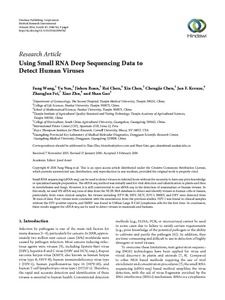Small RNA sequencing (sRNA-seq) can be used to detect viruses in infected hosts without the necessity to have any prior knowledge or specialized sample preparation. The sRNA-seq method was initially used for viral detection and identification in plants and then in invertebrates and fungi. However, it is still controversial to use sRNA-seq in the detection of mammalian or human viruses. In this study, we used 931 sRNA-seq runs of data from the NCBI SRA database to detect and identify viruses in human cells or tissues, particularly from some clinical samples. Six viruses including HPV-18, HBV, HCV, HIV-1, SMRV, and EBV were detected from 36 runs of data. Four viruses were consistent with the annotations from the previous studies. HIV-1 was found in clinical samples without the HIV-positive reports, and SMRV was found in Diffuse Large B-Cell Lymphoma cells for the first time. In conclusion, these results suggest the sRNA-seq can be used to detect viruses in mammals and humans.
Using small RNA deep sequencing data to detect human viruses
Citation: Wang, F.; Sun, Y.; Ruan, J.; Chen, R.; Chen, X.; Kreuze, J.F.; Fei, Z.J.; Zhu, X.; Gao, S. 2016. Using small RNA deep sequencing data to detect human viruses. BioMed Research International. (USA). ISSN 2314-6133. 2016(ID 2596782):9 p.
2016-04-07
CROP PROTECTION
journal_article

